Enhanced Photocatalytic and Anticancer Activity of Zn-Doped BaTiO3 Nanoparticles Prepared through a Green Approach Using Banana Peel Extract
Abstract
:1. Introduction
2. Results and Discussion
2.1. XRD Analysis
2.2. Electron Microscopy Analysis
2.3. XPS Analysis
2.4. Brunauer–Emmett–Teller (BET) Analysis
2.5. Raman Analysis
2.6. Photoluminescence (PL) Analysis
2.7. Photocatalytic Analysis
2.8. Anticancer Study
2.9. Cytocompatibility Study
3. Materials and Methods
3.1. Preparation of Banana Peel Extract
3.2. Eco-Friendly Production of Zn-Doped BaTiO3 Nanoparticles
3.3. Characterization
3.4. Photocatalytic Evaluation
3.5. Biological Assays
4. Conclusions
Author Contributions
Funding
Data Availability Statement
Conflicts of Interest
References
- Qi, J.; Li, Y.; Zhang, X.; Wang, J.; Zhang, Q.; Xue, Y.; Cheng, J.; Li, M.; Han, X.; Ma, Z.; et al. Solid-State Synthesis Semiconducting BaTiO3 Nanoparticles at Low Temperature. Mater. Chem. Phys. 2020, 242, 122496. [Google Scholar] [CrossRef]
- Jiang, B.; Iocozzia, J.; Zhao, L.; Zhang, H.; Harn, Y.W.; Chen, Y.; Lin, Z. Barium Titanate at the Nanoscale: Controlled Synthesis and Dielectric and Ferroelectric Properties. Chem. Soc. Rev. 2019, 48, 1194–1228. [Google Scholar] [CrossRef]
- Khan, M.A.M.; Kumar, S.; Ahmed, J.; Ahamed, M.; Kumar, A. Influence of Silver Doping on the Structure, Optical and Photocatalytic Properties of Ag-Doped BaTiO3 Ceramics. Mater. Chem. Phys. 2021, 259, 124058. [Google Scholar] [CrossRef]
- Singh, M.; Yadav, B.C.; Ranjan, A.; Kaur, M.; Gupta, S.K. Synthesis and Characterization of Perovskite Barium Titanate Thin Film and Its Application as LPG Sensor. Sens. Actuators B Chem. 2017, 241, 1170–1178. [Google Scholar] [CrossRef]
- Marino, A.; Almici, E.; Migliorin, S.; Tapeinos, C.; Battaglini, M.; Cappello, V.; Marchetti, M.; de Vito, G.; Cicchi, R.; Pavone, F.S.; et al. Piezoelectric Barium Titanate Nanostimulators for the Treatment of Glioblastoma Multiforme. J. Colloid Interface Sci. 2019, 538, 449–461. [Google Scholar] [CrossRef] [PubMed]
- Sood, A.; Desseigne, M.; Dev, A.; Maurizi, L.; Kumar, A.; Millot, N.; Han, S.S. A Comprehensive Review on Barium Titanate Nanoparticles as a Persuasive Piezoelectric Material for Biomedical Applications: Prospects and Challenges. Small 2023, 19, 2206401. [Google Scholar] [CrossRef]
- Luo, B.; Wang, X.; Tian, E.; Li, G.; Li, L. Electronic Structure, Optical and Dielectric Properties of BaTiO3/CaTiO3/SrTiO3 Ferroelectric Superlattices from First-Principles Calculations. J. Mater. Chem. C 2015, 3, 8625. [Google Scholar] [CrossRef]
- Khan, M.A.M.; Kumar, S.; Ahamed, M.; Ahmed, J.; Kumar, A.; Shar, M.A. BaTiO3@rGO Nanocomposite: Enhanced Photocatalytic Activity as Well as Improved Electrode Performance. J. Mater. Sci. Mater. Electron. 2021, 32, 12911–12921. [Google Scholar] [CrossRef]
- Xie, L.; Hao, J.G.; Chen, H.Q.; Li, Z.X.; Ge, S.Y.; Mi, Y.; Yang, K.; Lu, K.Q. Recent Advances of Nickel Hydroxide-Based Cocatalysts in Heterogeneous Photocatalysis. Catal. Commun. 2022, 162, 106371. [Google Scholar] [CrossRef]
- Tihtih, M.; Ibrahim, J.E.F.M.; Basyooni, M.A.; En-Nadir, R.; Belaid, W.; Hussainova, I.; Kocserha, I. Development of Yttrium-Doped BaTiO3 for Next-Generation Multilayer Ceramic Capacitors. ACS Omega 2023, 8, 8448–8460. [Google Scholar] [CrossRef]
- Chakraborty, T.; Mukherjee, S.; Mukherjee, S. Effect of Zn Doping on the Crystallization, Dielectric, and Ferroelectric Properties of Solid State Sintered Barium Stannate. InterCeram Int. Ceram. Rev. 2017, 66, 101–110. [Google Scholar] [CrossRef]
- Arunkumar, D.R.; Anjelin Ursula Portia, S.; Ramamoorthy, K. Design and Fabrication of Novel Tb Doped BaTiO3 Thin Film with Superior Light-Harvesting Characteristics for Dye Sensitized Solar Cells. Surf. Interfaces 2021, 22, 100853. [Google Scholar] [CrossRef]
- Singh, J.; Dutta, T.; Kim, K.H.; Rawat, M.; Samddar, P.; Kumar, P. “Green” Synthesis of Metals and Their Oxide Nanoparticles: Applications for Environmental Remediation. J. Nanobiotechnol. 2018, 16, 84. [Google Scholar] [CrossRef] [PubMed]
- Behzad, F.; Naghib, S.M.; Kouhbanani, M.A.J.; Tabatabaei, S.N.; Zare, Y.; Rhee, K.Y. An Overview of the Plant-Mediated Green Synthesis of Noble Metal Nanoparticles for Antibacterial Applications. J. Ind. Eng. Chem. 2021, 94, 92–104. [Google Scholar] [CrossRef]
- Kalpana, V.N.; Devi Rajeswari, V. A Review on Green Synthesis, Biomedical Applications, and Toxicity Studies of ZnO NPs. Bioinorg. Chem. Appl. 2018, 2018, 3569758. [Google Scholar] [CrossRef]
- Mohd Zaini, H.; Roslan, J.; Saallah, S.; Munsu, E.; Sulaiman, N.S.; Pindi, W. Banana Peels as a Bioactive Ingredient and Its Potential Application in the Food Industry. J. Funct. Foods 2022, 92, 105054. [Google Scholar] [CrossRef]
- Ruangtong, J.; Jiraroj, T.; T-Thienprasert, N.P. Green Synthesized ZnO Nanosheets from Banana Peel Extract Possess Anti-Bacterial Activity and Anti-Cancer Activity. Mater. Today Commun. 2020, 24, 101224. [Google Scholar] [CrossRef]
- Goh, H.T.; Cheok, C.Y.; Yeap, S.P. Green Synthesis of Silver Nanoparticles Using Banana Peel Extract and Application on Banana Preservation. Food Front. 2023, 4, 283–288. [Google Scholar] [CrossRef]
- Ahamed, M.; Khan, M.A.M.; Akhtar, M.J.; Alhadlaq, H.A.; Alshamsan, A. Role of Zn Doping in Oxidative Stress Mediated Cytotoxicity of TiO2 Nanoparticles in Human Breast Cancer MCF-7 Cells. Sci. Rep. 2016, 6, 30196. [Google Scholar] [CrossRef] [Green Version]
- Patterson, A.L. The Scherrer Formula for X-ray Particle Size Determination. Phys. Rev. 1939, 56, 978–982. [Google Scholar] [CrossRef]
- Ahamed, M.; Akhtar, M.J.; Khan, M.A.M.; Alaizeri, Z.M.; Alhadlaq, H. Facile Synthesis of Zn-Doped Bi2O3 nanoparticles and Their Selective Cytotoxicity toward Cancer Cells. ACS Omega 2021, 6, 17353–17361. [Google Scholar] [CrossRef] [PubMed]
- Narasimman, S.; Balakrishnan, L.; Alex, Z.C. Fiber Optic Magnetic Field Sensor Using Co Doped ZnO Nanorods as Cladding. RSC Adv. 2018, 8, 18243–18251. [Google Scholar] [CrossRef] [PubMed] [Green Version]
- Bhat, D.K.; Bantawal, H.; Shenoy, U.S. Rhodium Doping Augments Photocatalytic Activity of Barium Titanate: Effect of Electronic Structure Engineering. Nanoscale Adv. 2020, 2, 5688–5698. [Google Scholar] [CrossRef] [PubMed]
- Hayashi, H.; Nakamura, T.; Ebina, T. In-Situ Raman Spectroscopy of BaTiO3 Particles for Tetragonal–Cubic Transformation. J. Phys. Chem. Solids 2013, 74, 957–962. [Google Scholar] [CrossRef]
- Uma, P.I.; Shenoy, U.S.; Bhat, D.K. Electronic Structure Engineering of BaTiO3 Cuboctahedrons by Doping Copper to Enhance the Photocatalytic Activity for Environmental Remediation. J. Alloys Compd. 2023, 948, 169600. [Google Scholar] [CrossRef]
- Xu, S.; Liu, Z.; Zhang, M.; Guo, L. Piezotronics Enhanced Photocatalytic Activities of Ag-BaTiO3 Plasmonic Photocatalysts. J. Alloys Compd. 2019, 801, 483–488. [Google Scholar] [CrossRef]
- Yu, C.; Wang, S.; Zhang, K.; Li, M.; Gao, H.; Zhang, J.; Yang, H.; Hu, L.; Jagadeesha, A.V.; Li, D. Visible-Light-Enhanced Photocatalytic Activity of BaTiO3/γ-Al2O3 Composite Photocatalysts for Photodegradation of Tetracycline Hydrochloride. Opt. Mater. 2023, 135, 113364. [Google Scholar] [CrossRef]
- Singh, S.; Kumar, A.; Pandey, S.K.; Kumar, V.; Verma, M.K.; Gupta, A.; Mandal, K.D. Synthesis of Bi4Ti3O12-BaTiO3 Nanocomposite, Manifesting High Dielectric and Unique Magnetic Nature Applicable in Heterogeneous Photocatalytic Activity for Degradation of Rhodamine B Dye. Mater. Technol. 2020, 36, 476–491. [Google Scholar] [CrossRef]
- Nagajyothi, P.C.; Muthuraman, P.; Tettey, C.O.; Yoo, K.; Shim, J. In Vitro Anticancer Activity of Eco-Friendly Synthesized ZnO/Ag Nanocomposites. Ceram. Int. 2021, 47, 34940–34948. [Google Scholar] [CrossRef]
- Rajendran, R.; Mani, A. Photocatalytic, Antibacterial and Anticancer Activity of Silver-Doped Zinc Oxide Nanoparticles. J. Saudi Chem. Soc. 2020, 24, 1010–1024. [Google Scholar] [CrossRef]
- Ahamed, M.; Akhtar, M.J.; Majeed Khan, M.A.; Alhadlaq, H.A.; Alshamsan, A. Barium Titanate (BaTiO3) Nanoparticles Exert Cytotoxicity through Oxidative Stress in Human Lung Carcinoma (A549) Cells. Nanomaterials 2020, 10, 2309. [Google Scholar] [CrossRef] [PubMed]
- Prashanth, G.K.; Prashanth, P.A.; Singh, P.; Nagabhushana, B.M.; Shivakumara, C.; Krishnaiah, G.M.; Nagendra, H.G.; Sathyananda, H.M.; Chaturvedi, V. Effect of Doping (with Cobalt or Nickel) and UV Exposure on the Antibacterial, Anticancer, and ROS Generation Activities of Zinc Oxide Nanoparticles. J. Asian Ceram. Soc. 2020, 8, 1175–1187. [Google Scholar] [CrossRef]
- Ciccarese, F.; Raimondi, V.; Sharova, E.; Silic-Benussi, M.; Ciminale, V. Nanoparticles as Tools to Target Redox Homeostasis in Cancer Cells. Antioxidants 2020, 9, 211. [Google Scholar] [CrossRef] [PubMed] [Green Version]
- Mosmann, T. Rapid Colorimetric Assay for Cellular Growth and Survival: Application to Proliferation and Cytotoxicity Assays. J. Immunol. Methods 1983, 65, 55–63. [Google Scholar] [CrossRef]
- Ahamed, M.; Javed Akhtar, M.; Majeed Khan, M.A.; Alhadlaq, H.A. Facile Green Synthesis of ZnO-RGO Nanocomposites with Enhanced Anticancer Efficacy. Methods 2022, 199, 28–36. [Google Scholar] [CrossRef]
- Ahamed, M.; Lateef, R.; Akhtar, M.J.; Rajanahalli, P. Dietary Antioxidant Curcumin Mitigates CuO Nanoparticle-Induced Cytotoxicity through the Oxidative Stress Pathway in Human Placental Cells. Molecules 2022, 27, 7378. [Google Scholar] [CrossRef]
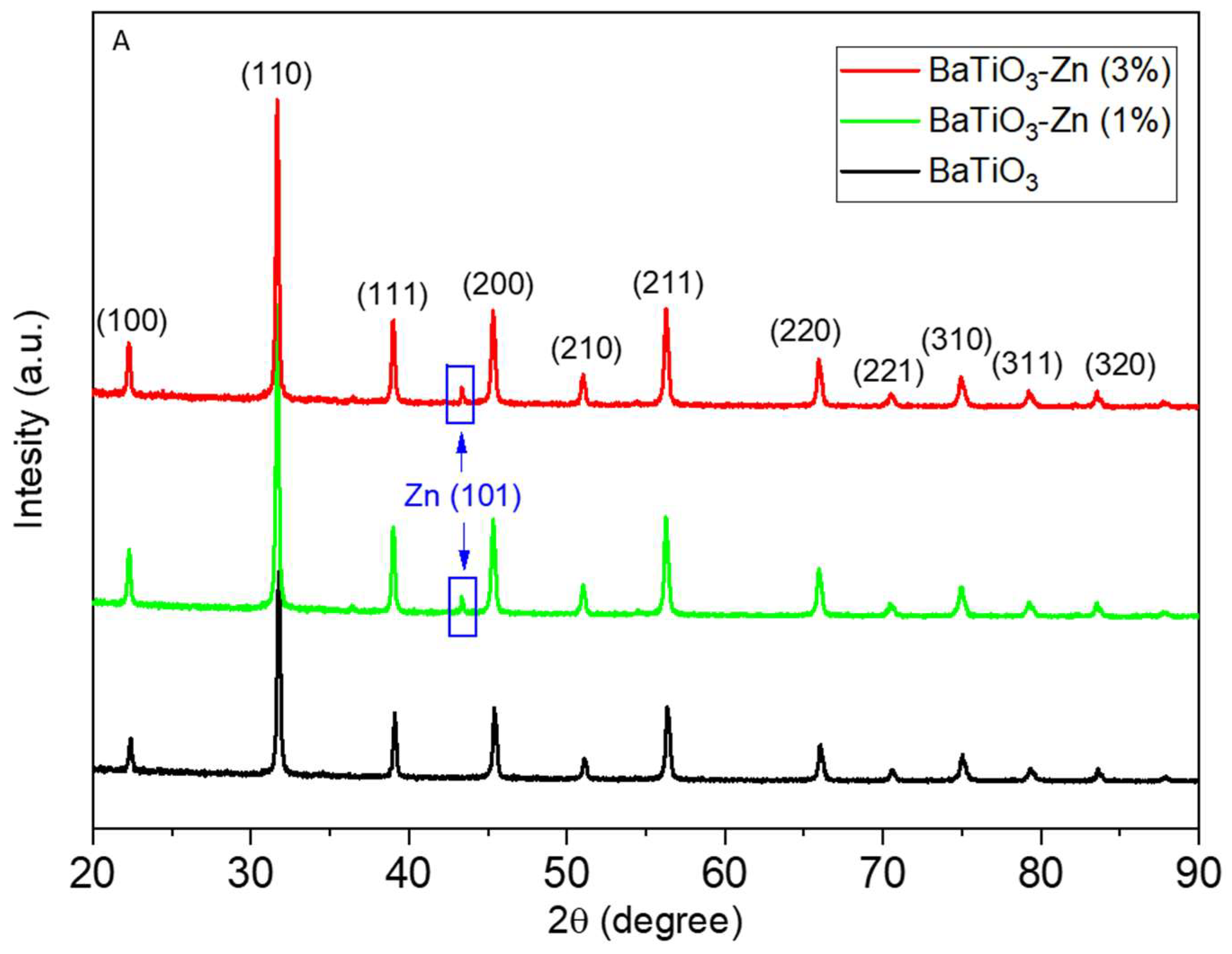
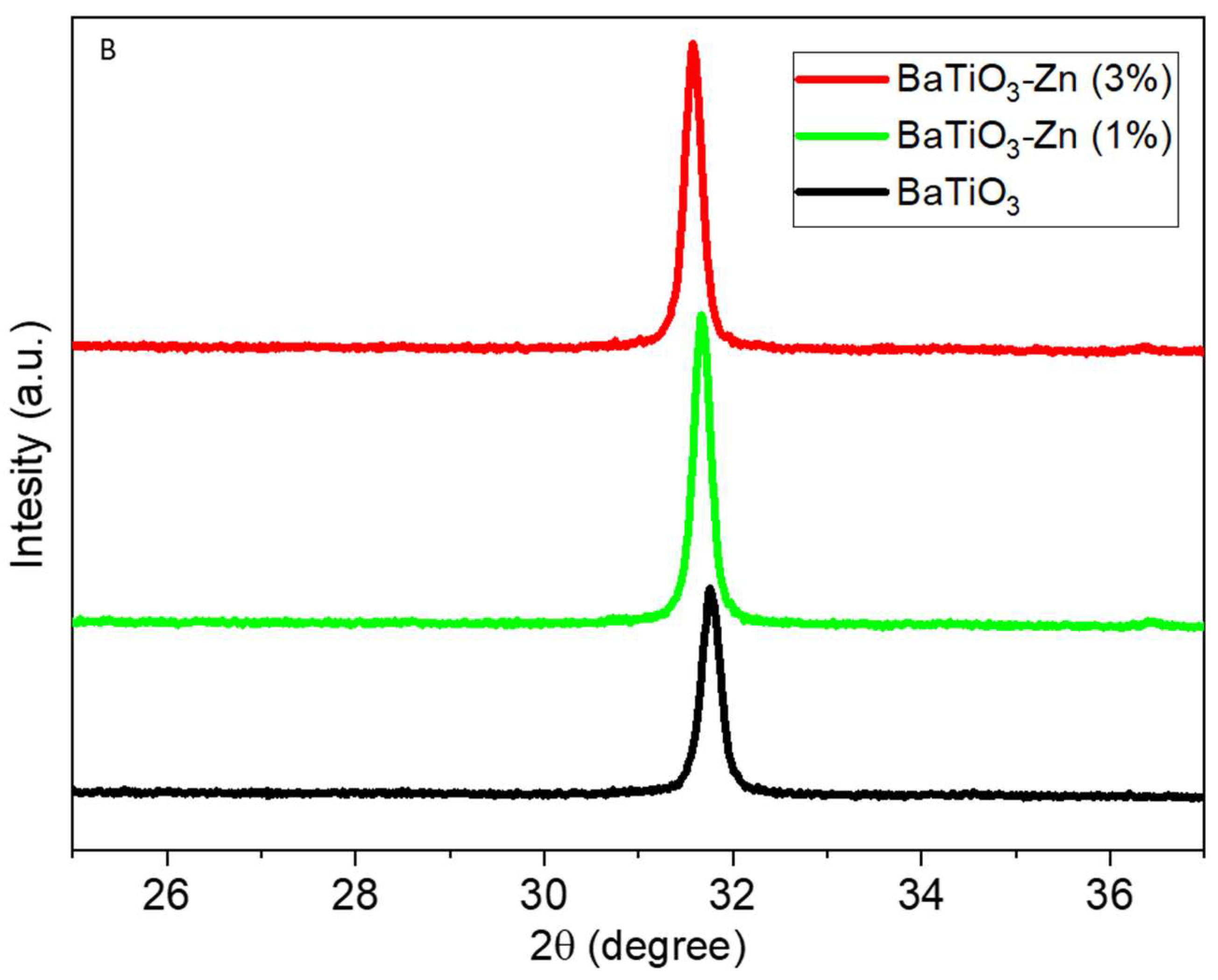
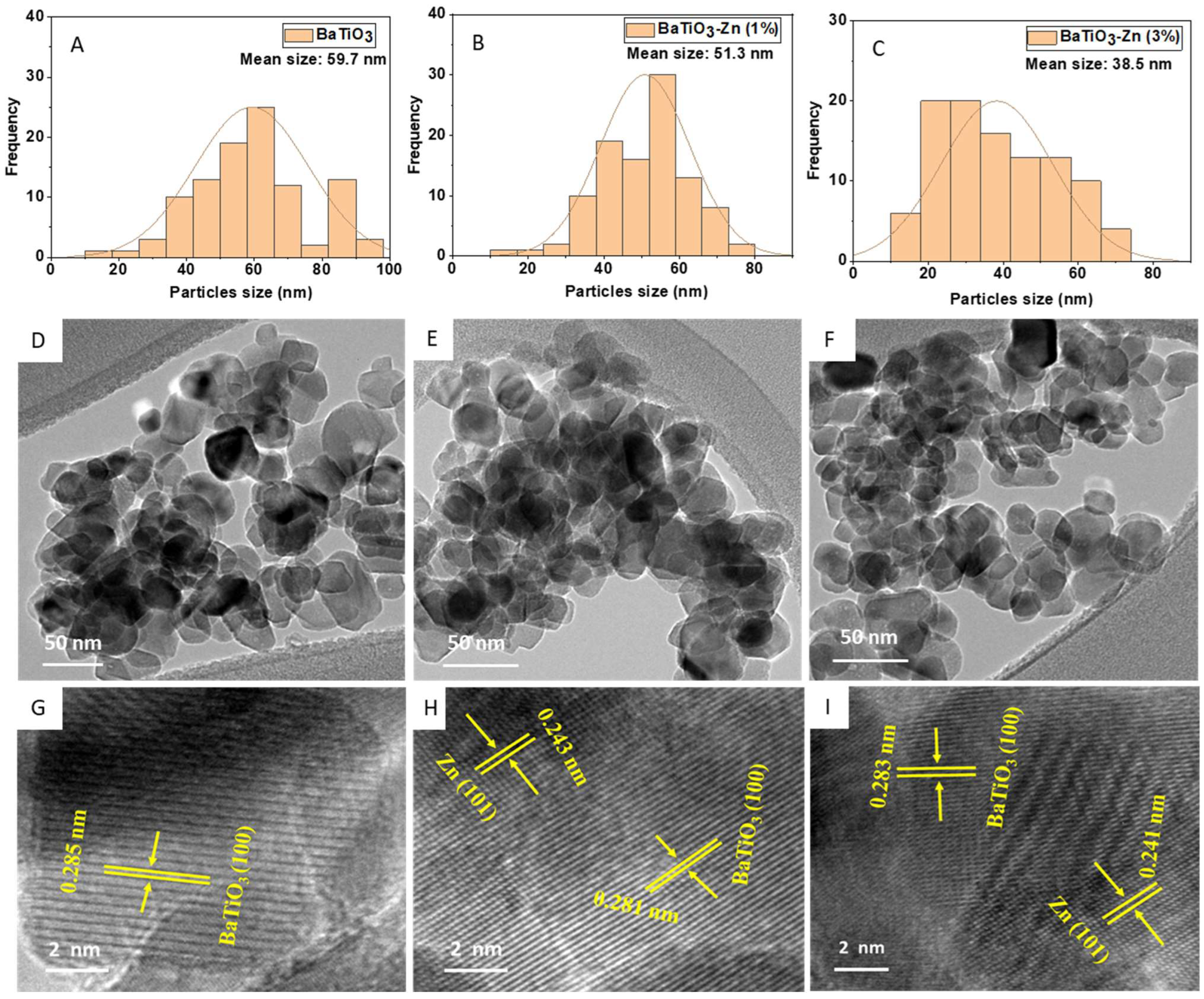
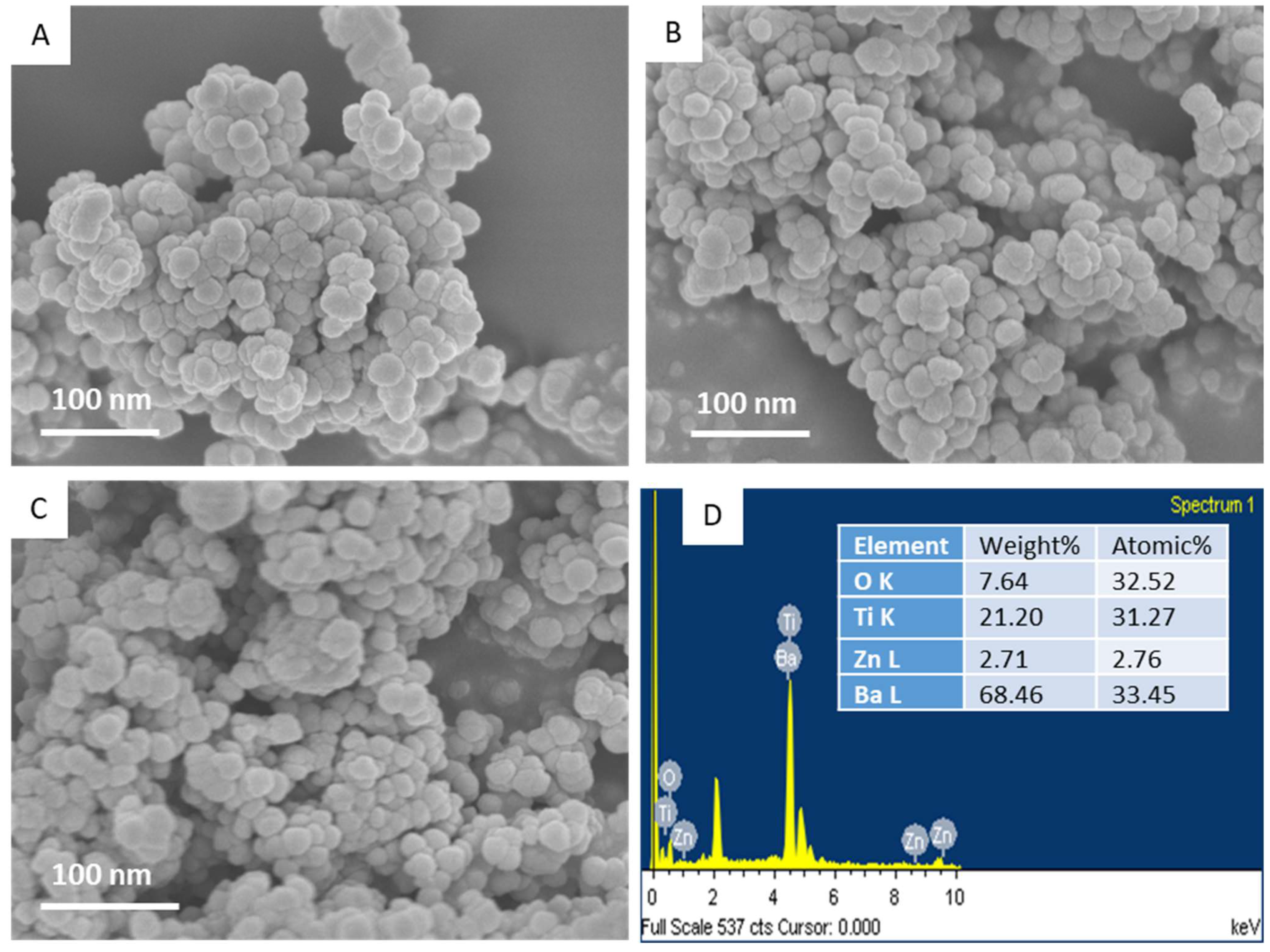

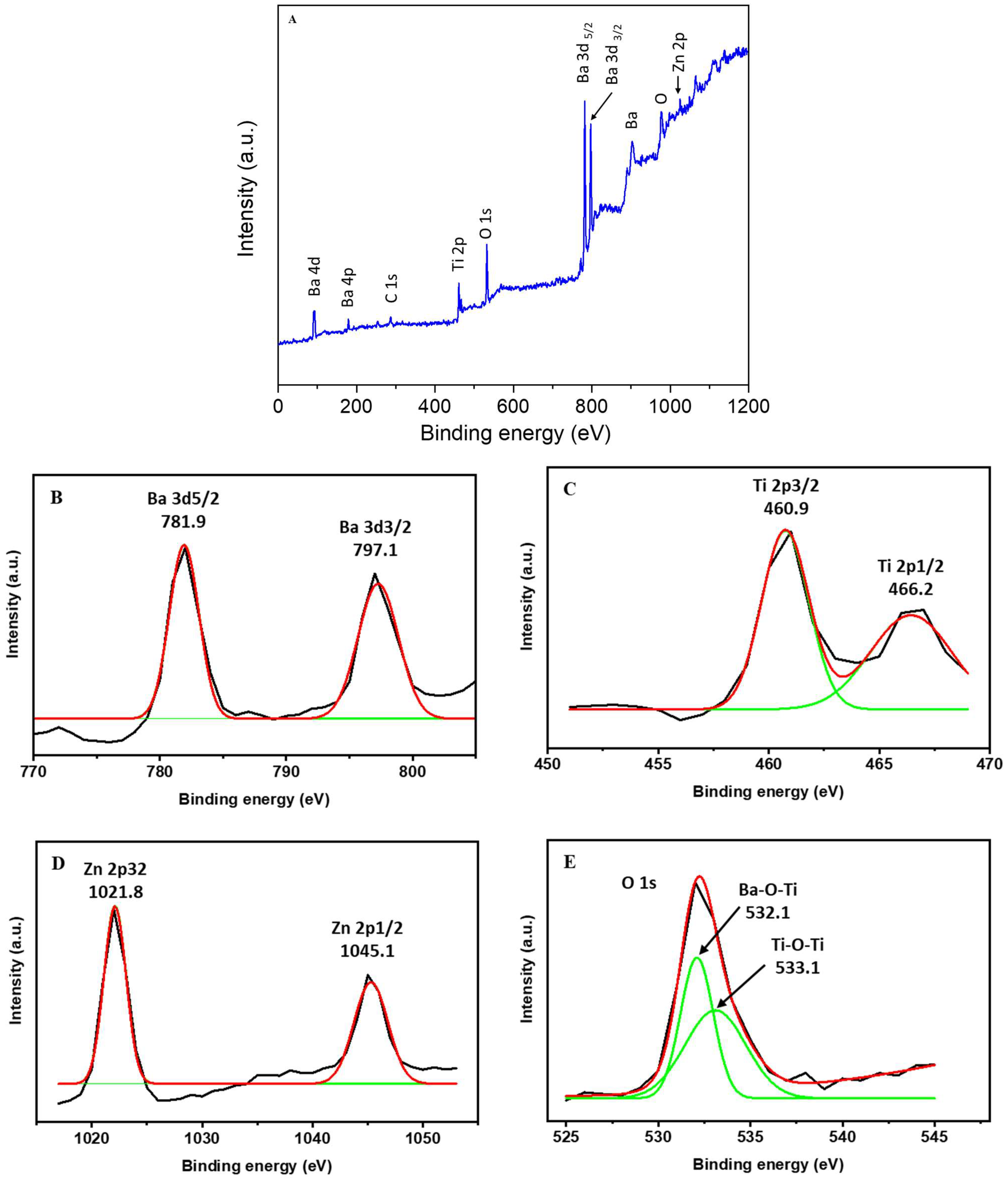

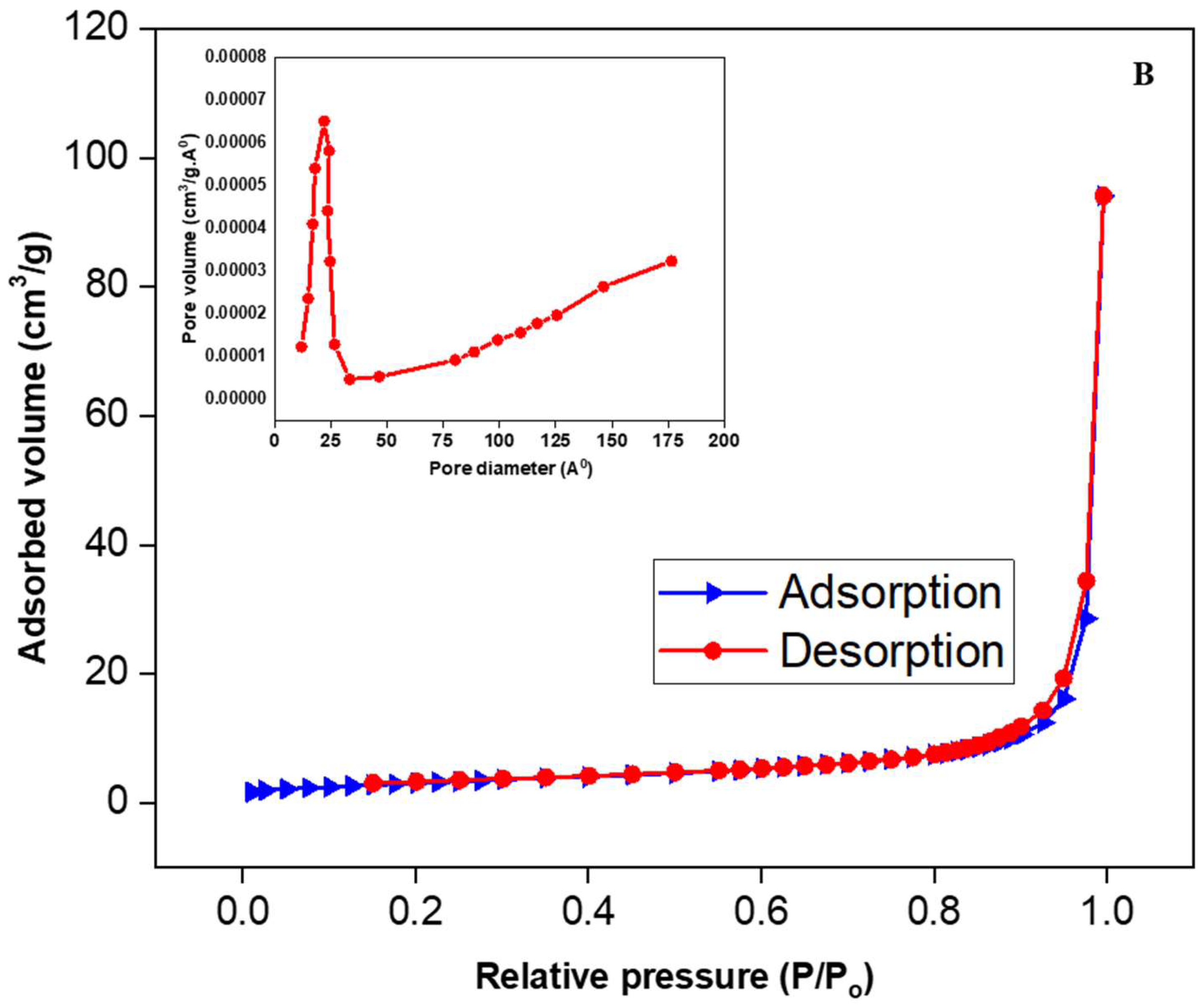
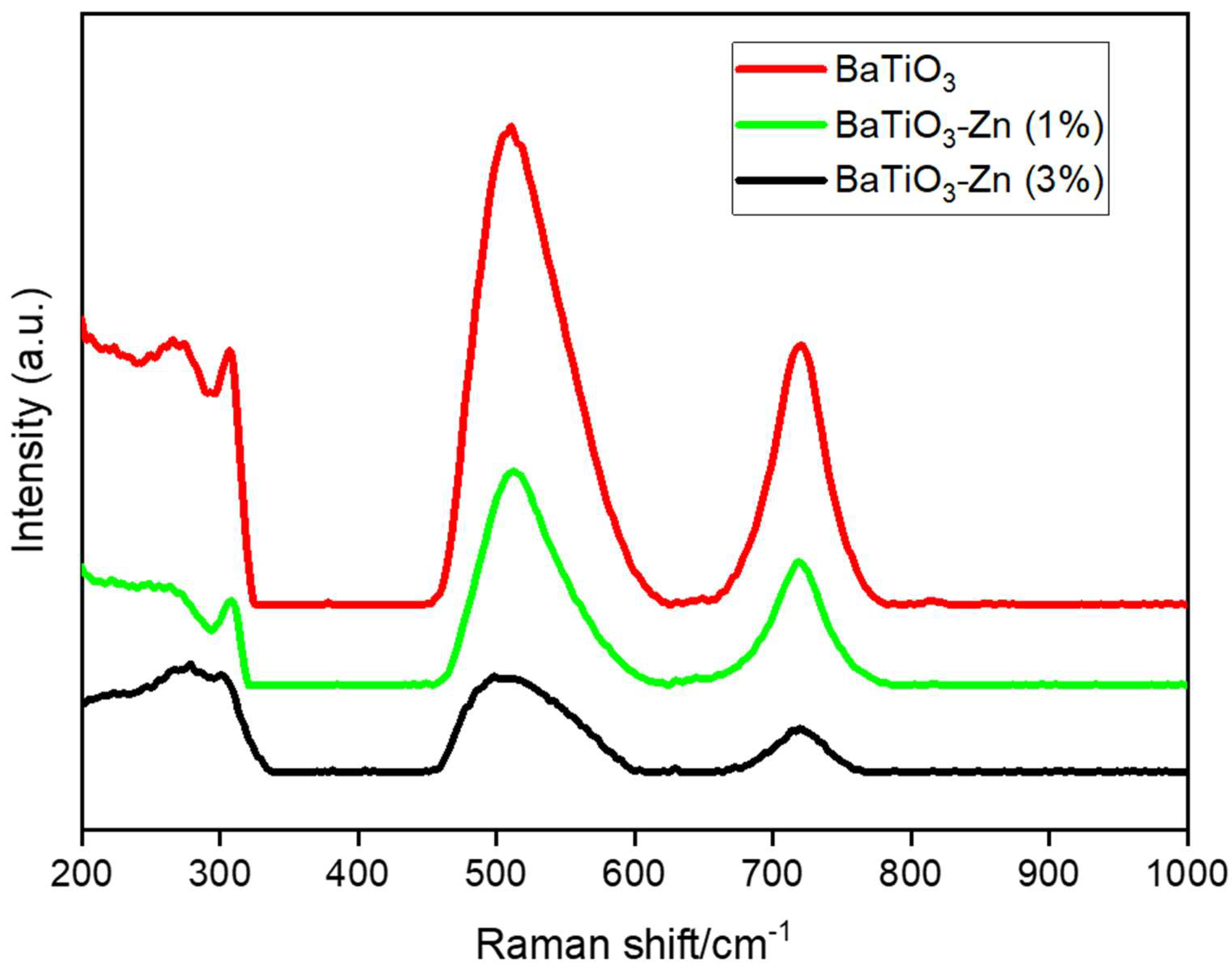
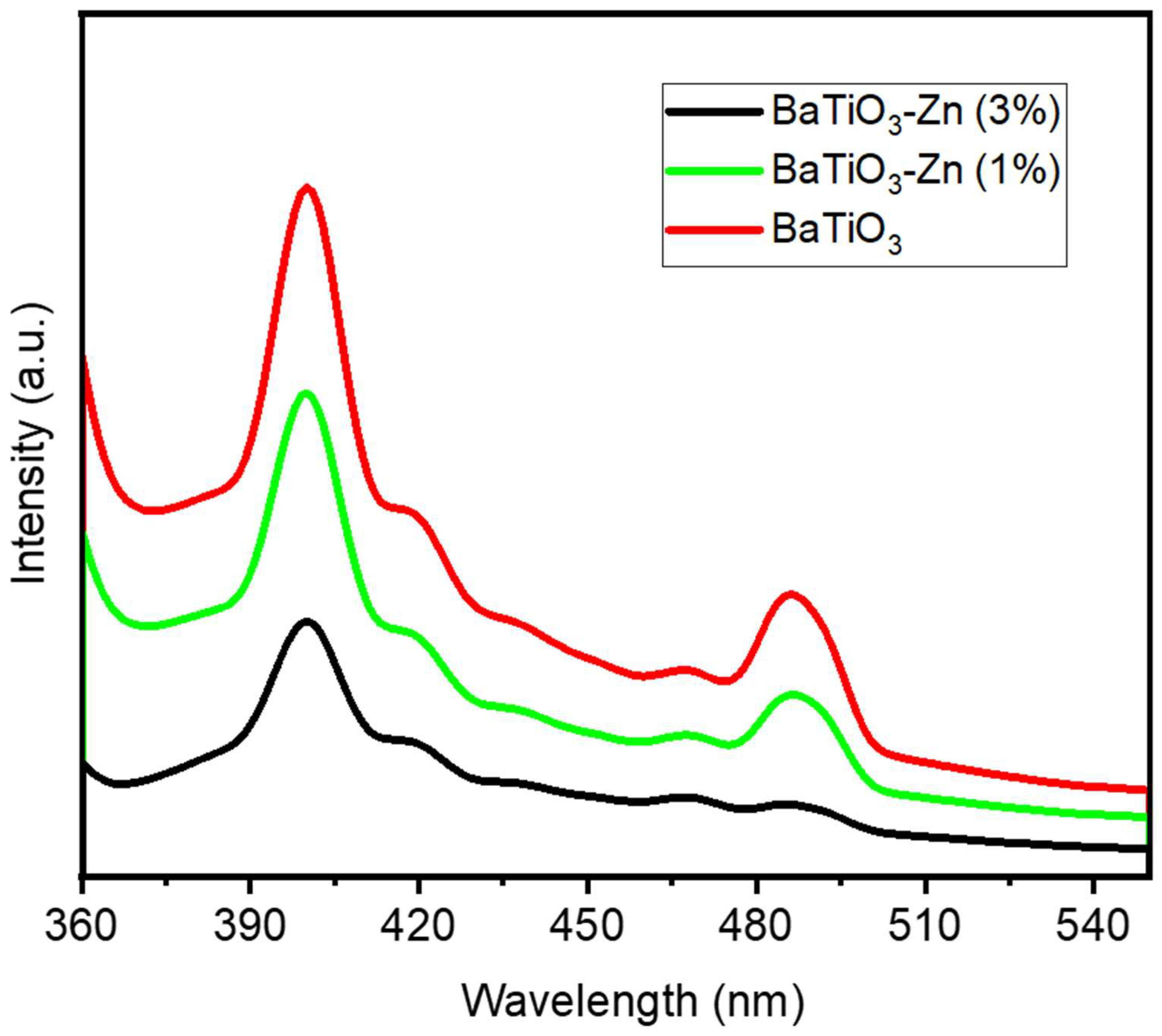



| Samples | Pollutants | Light Source | Exposure Time | Degradation Efficiency (%) | References |
|---|---|---|---|---|---|
| Zn–BaTiO3 nanoparticles | Methylene blue | Visible | 80 min | 85% | Present work |
| Cu–BaTiO3 nanoparticles | methyl violet | Visible | 120 min | 99% | [25] |
| Ag–BaTiO3 nanoparticles | Rhodamine B | UV | 105 min | 79% | [3] |
| Ag–BaTiO3 nanoparticles | Rhodamine B | UV | 75 min | 83% | [26] |
| BaTiO3@rGO nanocomposites | Methylene blue | Visible | 200 min | 96% | [8] |
| BaTiO3/γ–Al2O3 composite | tetracycline hydrochloride | Visible | 120 min | 91% | [27] |
| Bi4Ti3O12–BaTiO3 nanocomposite | Rhodamine B | Solar | 60 min | 43% | [28] |
Disclaimer/Publisher’s Note: The statements, opinions and data contained in all publications are solely those of the individual author(s) and contributor(s) and not of MDPI and/or the editor(s). MDPI and/or the editor(s) disclaim responsibility for any injury to people or property resulting from any ideas, methods, instructions or products referred to in the content. |
© 2023 by the authors. Licensee MDPI, Basel, Switzerland. This article is an open access article distributed under the terms and conditions of the Creative Commons Attribution (CC BY) license (https://creativecommons.org/licenses/by/4.0/).
Share and Cite
Ahamed, M.; Khan, M.A.M. Enhanced Photocatalytic and Anticancer Activity of Zn-Doped BaTiO3 Nanoparticles Prepared through a Green Approach Using Banana Peel Extract. Catalysts 2023, 13, 985. https://doi.org/10.3390/catal13060985
Ahamed M, Khan MAM. Enhanced Photocatalytic and Anticancer Activity of Zn-Doped BaTiO3 Nanoparticles Prepared through a Green Approach Using Banana Peel Extract. Catalysts. 2023; 13(6):985. https://doi.org/10.3390/catal13060985
Chicago/Turabian StyleAhamed, Maqusood, and M. A. Majeed Khan. 2023. "Enhanced Photocatalytic and Anticancer Activity of Zn-Doped BaTiO3 Nanoparticles Prepared through a Green Approach Using Banana Peel Extract" Catalysts 13, no. 6: 985. https://doi.org/10.3390/catal13060985






